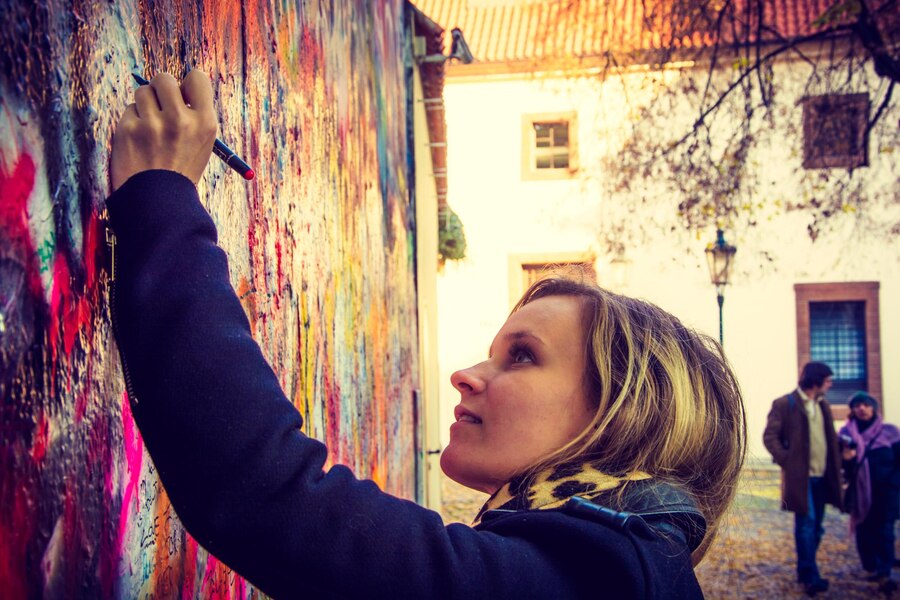Street art is a vibrant form of expression, bringing together diverse cultures, political messages, and artistic styles in public spaces. From colorful murals on city walls to thought-provoking graffiti stenciled on forgotten alleyways, street art has become a global phenomenon, transcending traditional boundaries and turning cities into open-air galleries.
This article delves into inspirational street art stories from around the world, showcasing how street art has evolved and made profound impacts on urban landscapes, social movements, and cultural identities.

The Rise of Street Art: A Global Movement
Street art began as a form of rebellion, often used as a means of protest against societal norms or to amplify voices that felt unheard. Early forms of graffiti in the late 20th century, such as the works of Jean-Michel Basquiat or Keith Haring, laid the foundation for modern street art, which continues to serve as both an artistic and political tool. Today, street art is celebrated in galleries, museums, and even auction houses, yet it retains its rebellious, boundary-pushing spirit in the streets. One of the most famous examples of street art becoming an influential cultural force is the work of Banksy, whose politically charged stencils have made waves globally.
Street art is not confined to one particular style or message; it is as diverse as the artists who create it. From realistic portraits to abstract murals, street artists continue to experiment with colors, textures, and materials to communicate their messages. The democratic nature of street art—anyone can be an artist, and anyone can be a viewer—has made it a vehicle for social change and a platform for marginalized communities to share their stories with the world.
Read more about the global rise of street art.
The Intersection of Politics and Art
One of the most compelling aspects of street art is its ability to convey political and social messages in a direct, accessible way. This is particularly evident in cities with turbulent histories, where street art has been used as a tool for protest, resistance, and empowerment.
Take, for example, the Belfast murals in Northern Ireland, which depict the struggles between Protestants and Catholics during the Troubles. These murals, while controversial, serve as powerful visual representations of political conflicts and are now an integral part of Belfast’s identity, attracting tourists from all over the world. The murals continue to evolve, with artists incorporating contemporary issues like the fight for women’s rights, environmental justice, and LGBTQ+ equality into their works.
Similarly, in the Gaza Strip, street art has become a vital part of the Palestinian resistance against the Israeli occupation. Artists like Taymour Sulaiman and Laila Shawa have used street art to express messages of hope, defiance, and resistance in the face of oppression. Their works, often created on the walls of destroyed buildings, turn the streets into powerful symbols of resilience and solidarity.
Explore the intersection of politics and street art.
Inspiring Social Movements Through Art
Street art has also played a central role in mobilizing social movements. A poignant example of this is the “Black Lives Matter” mural painted in Washington, D.C. after the murder of George Floyd. This mural, which was created in 2020, became an international symbol of the fight for racial justice.
The mural, painted in large, bold letters across the street in front of the White House, served as a powerful reminder of the movement’s core message: that Black lives matter. It also attracted global attention, inspiring similar murals in cities across the United States and around the world.
In Brazil, street artists have been at the forefront of fighting for the rights of indigenous people. The work of Eduardo Kobra, a Brazilian artist known for his colorful and large-scale murals, often incorporates themes of Indigenous identity, environmentalism, and social justice. One of his most famous pieces, the mural of Chief Raoni in São Paulo, celebrates the resilience of indigenous peoples and the importance of protecting the Amazon rainforest.
Learn about street art’s role in social movements.
Famous Street Art Stories from Around the World
Street art has a global reach, and its stories resonate across continents. Let’s explore a few of the most inspirational street art stories that have made an impact in different parts of the world.
The “Hope” Mural by Shepard Fairey
One of the most famous street art stories from the United States is the creation of the “Hope” poster during the 2008 presidential election. Designed by artist Shepard Fairey, the iconic image of Barack Obama with the word “Hope” underneath became an emblem of change and optimism during Obama’s campaign.
The image was reproduced on posters, t-shirts, and other materials, helping to solidify Obama’s image as a transformative figure. This work, which began as a street art project, quickly transcended the urban landscape and became a significant part of American political history.
Read about Shepard Fairey’s impact on street art.
Banksy’s Political Street Art
No discussion of inspirational street art is complete without mentioning Banksy, one of the most influential street artists of our time. Known for his satirical and politically charged works, Banksy has used the streets as his canvas to address issues such as war, poverty, and consumerism.
His works often stenciled onto public walls, have sparked debates around the legitimacy of street art as high art, the commercialization of art, and the role of art in protest movements.
One of his most famous pieces, “There Is Always Hope”, is a stencil of a girl letting go of a balloon. The piece has become a symbol of lost innocence and the fragility of hope. In 2018, the piece made headlines when it was partially shredded right after being sold at auction for over a million dollars.
This act of artistic subversion was a statement on the commodification of art and has only added to Banksy’s mystique and influence.
Discover more about Banksy’s revolutionary street art.
The 5Pointz Project (New York)
For over two decades, the 5Pointz graffiti and street art complex in Long Island City, New York, served as a mecca for street artists from around the world. The 5Pointz building, a sprawling warehouse covered in graffiti, was known for its collaborative spirit and the freedom it gave artists to express themselves without the constraints of galleries or commercial interests.
Unfortunately, in 2013, the building was demolished to make way for luxury apartments, sparking outrage in the street art community.
The demolition of 5Pointz highlighted the ongoing tension between the artistic community and the forces of gentrification that threaten urban spaces. However, the legacy of 5Pointz lives on through the work of its artists and the murals that were preserved in memory of the complex.
Read more about the legacy of 5Pointz.
Inspirational Street Art Around the World: A Comparative Table
| City | Artist(s) | Famous Mural | Themes | Significance |
|---|---|---|---|---|
| London | Banksy | “There Is Always Hope” | Political subversion, hope | Symbol of lost innocence and political critique |
| Belfast | Various local artists | Political Murals | Conflict, identity | Reflection of Northern Ireland’s troubled history |
| São Paulo | Eduardo Kobra | “Chief Raoni” | Indigenous rights, environment | Advocacy for environmental and Indigenous issues |
| Washington, D.C. | Various Artists | “Black Lives Matter” mural | Racial justice, protest | A symbol of global solidarity for racial justice |
| Gaza | Taymour Sulaiman, Laila Shawa | Various murals | Resistance, hope | Street art as a form of resistance and resilience |
Frequently Asked Questions (FAQs)
What is street art?
Street art is any art created in public spaces, often without official permission. It includes various forms such as graffiti, murals, stencils, and installations. It is typically used to express social, political, or personal messages.
Why is street art important?
Street art serves as a powerful medium for social change, offering a platform for underrepresented voices. It transforms public spaces into canvases for protest, identity, and storytelling. It also makes art more accessible to the general public.
Who are the most famous street artists in the world?
Some of the most famous street artists include Banksy, Shepard Fairey, Keith Haring, Jean-Michel Basquiat, and Eduardo Kobra. These artists have significantly influenced street art’s global impact and elevated its cultural importance.
What is the significance of street art in social movements?
Street art has been instrumental in shaping social movements by amplifying messages of resistance, justice, and equality. It provides an accessible, visible platform for protest and can capture the sentiments of a movement in powerful, lasting ways.
Can street art be considered fine art?
Yes, many forms of street art have been recognized as legitimate fine art. Artists like Banksy and Shepard Fairey have exhibited their works in galleries and museums worldwide, proving that street art can transcend its urban roots and become a respected form of high art.
Conclusion
Inspirational street art stories from around the world reveal the incredible power of art in public spaces to transform communities, spark social movements, and challenge conventional notions of beauty and expression.
From the politically charged murals of Northern Ireland to the vibrant graffiti of Brazil and the global influence of artists like Banksy, street art is much more than just a form of creative expression—it is a tool for change, a voice for the voiceless, and a reflection of the dynamic, ever-changing world we live in.
As cities continue to evolve and urban spaces become canvases for new generations of artists, street art will undoubtedly remain a key player in shaping both public opinion and cultural narratives.
Whether celebrating diversity, advocating for social justice, or simply sharing a personal story, street art provides a unique and powerful lens through which to view the world.
So, next time you walk through a city street or alleyway, take a moment to appreciate the art that surrounds you. It’s not just paint on a wall—it’s history in the making, a statement of defiance, or a message of hope that can inspire and connect us all.




